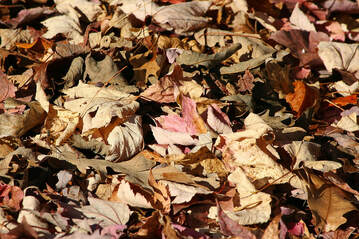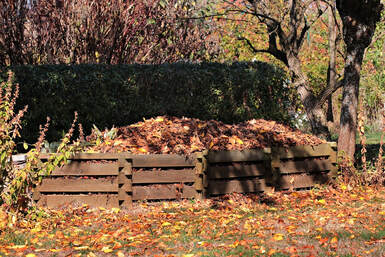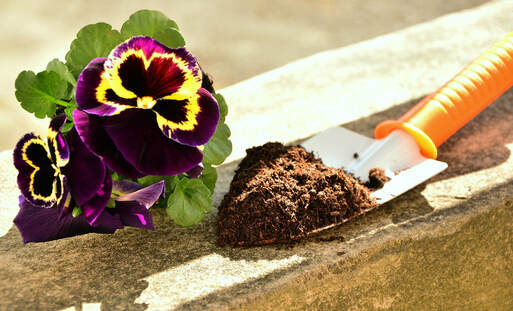The Importance of Organic Matter  Every fall I get exasperated as I see piles of leaves accumulate on the side of the road that will end up in a landfill. There are multiple reasons why I find this practice upsetting. Heathy soil is one of the foundations for healthy plants and organic matter is a critical component of a healthy soil. Organic matter in the soil evolves from the natural process of recycling plant matter and, to an extent, animal matter. Given the opportunity, leaves can be decomposed by microbes and micro-fauna into the very important soil component of organic matter. Organic matter is broken down further into the components of carbohydrates, proteins, peptides, amino acids, fats, waxes, lipids and very importantly, humus. Organic matter is typically composed of about 65-75% humus. Humus cannot be easily broken down and so, along with minerals, can persist in the soil for hundreds of years. To understand how important humus in the soil is to plants one needs to understand how nutrients in the soil become available to plant roots. Nutrients in the form of either cations (positively charged) or anions (negative charged) are attracted to and adsorbed to soil particles or colloids which are also charged. The most important types of soil colloids are composed of silicate clays, iron or aluminum oxides or humus. Of most importance is the negative charge of these colloids that will attract and adsorb what is referred to as the cation exchange capacity or complex (CEC). It is these cations in the CEC that plant roots absorb. Macro and micro nutrients necessary for plant growth that are adsorbed as cations by soil colloids and then absorbed by roots are ammonium (NH4 + ), potassium (K+ ), calcium (Ca2+), magnesium (Mg2+), iron (Fe2+), manganese (Mn2+), nickel (Ni2+) and zinc (Zn2+). The net negative charge varies for the different soil colloid types. The higher the amount of charge the higher the number of the cations above that can be adsorbed by colloids and this is where humus really stands out. The clay colloids with the highest net charge will be in the range of -100 to -200. The charge on humus can be as high as -500 which means it can adsorb 2.5 to 5 times as many cations. Humus has other positive characteristics too. It helps create soil structure which improves soil aeration and at the same time improves the water holding capacity. Soils high in organic matter will contain more microbes and micro and macro fauna that are also beneficial to plant growth. So simply put, a soil high in humus or organic matter is a much more fertile and productive soil. Muck soils, also known as Histosols, are some of the most productive soils in the US and are used predominantly for vegetable production. They are comprised of at least 20% organic matter and may be as high as 80%. For comparison, typical clay soils (Ultisols) of the southeastern US have less than 5% organic matter-probably closer to 2- 3%. Sandy soils of the southeastern US may only have 1% organic matter or less. So, what can a person do to increase the organic matter in their soil? Save those leaves!  Composting fallen leaves is one option but the easiest practice is to use them as mulch under the trees that dropped them. This practice can greatly improve the health of shade trees in numerous ways. Mulch, besides contributing organic matter to the soil, can help hold soil moisture during drought, can prevent soil compaction, can increase the number of earthworms which contribute to soil fertility and aeration, can moderate soil temperatures and prevent the growth of weeds. Leaves can also be used as a mulch under shrubs, in the vegetable garden and under fruiting trees, bushes and vines. The leaves will break down quickly once temperatures warm up in the spring and by midsummer they will have basically disappeared. By the time leaves start falling again it will be time to replenish the mulch. Many folks have heard animal manures and composts referred to as “black gold”. I like to refer to leaves as “brown gold”. People will pay lots of money for bags of compost and mulch when they have lots of “brown gold” in their own yard. Why not keep your money by keeping your leaves? That is certainly what I do. The main question that I have gotten about using leaves in my yard under large shade trees concerns whether the leaves blow back out into the yard? Some will but most don’t. To help keep them in place I use pine straw scattered lightly on top of the leaves (fortunately I have pine trees also). A thin layer of bark mulch would do the same. And remember those leaves will start breaking down in just a few months. Once that process begins, they will not be going anywhere except into the soil. I also get the response from lawn lovers that they want grass growing under their trees. Typically, that is a lose/lose situation for both the lawn and the trees. Neither will be in optimum health. Mulch under trees is much more aesthetically pleasing than a sparse, unhealthy lawn full of weeds. It is much more sensible to place a mulch at least under the tree canopy. A 3”-4” layer is all that is needed but be sure to keep the mulch away from the base of the tree. Another benefit of keeping those leaves in your yard is to keep them out of landfills. It costs you and the community money to put them there. Why pay to remove something that can be beneficial to keep? Comments are closed.
|
Categories
All
Archives
June 2024
|


 RSS Feed
RSS Feed



